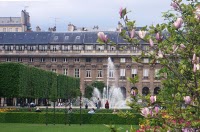Paris Monuments - The Palais Royal
 Sunday, June 28, 2009 at 4:00PM Tweet
Sunday, June 28, 2009 at 4:00PM Tweet  One of my favorite Paris places is the garden of the Palais Royal, a gem hiding in plain sight right in the middle of town. Indeed, I’m embarrassed to admit that I had already lived here for two years before stumbling on it, having just missed it any number of times while visiting the Musée du Louvre or taking in a show at the Comédie Française. It was like finding an urban Shangri-la!
One of my favorite Paris places is the garden of the Palais Royal, a gem hiding in plain sight right in the middle of town. Indeed, I’m embarrassed to admit that I had already lived here for two years before stumbling on it, having just missed it any number of times while visiting the Musée du Louvre or taking in a show at the Comédie Française. It was like finding an urban Shangri-la!
The Palais Royal was first known as the Palais Cardinal, the home of Cardinal Richelieu, chief advisor to King Louis XIII (and some say the real power behind the throne). He built his beautiful home just across the street from the king who lived at the Palais du Louvre back when that part of today's 1st arrondissement sat at the very edge of the city (see map of Paris 1789).

 On his 13th birthday, in September 1652, Louis XIV declared himself King. He moved back to the Louvre Palace, where he lived for 30 years before transferring his family and the entire French government to Versailles in 1682. The Palais Royal remained the home of his younger brother, Philippe Duc d’Orleans. It would stay in the hands of the Orleans branch of the royal family for the next 150 years. By 1789, the Palais Royal was home to Philippe’s great-grandson, Louis-Philippe Joseph II Duc d’Orleans, the first cousin of King Louis XVI and royal member of the new National Assembly.
On his 13th birthday, in September 1652, Louis XIV declared himself King. He moved back to the Louvre Palace, where he lived for 30 years before transferring his family and the entire French government to Versailles in 1682. The Palais Royal remained the home of his younger brother, Philippe Duc d’Orleans. It would stay in the hands of the Orleans branch of the royal family for the next 150 years. By 1789, the Palais Royal was home to Philippe’s great-grandson, Louis-Philippe Joseph II Duc d’Orleans, the first cousin of King Louis XVI and royal member of the new National Assembly.
During their first century-and-a-half, the gardens of the Palais Royal were private, enclosed by the backs of houses that grew up around them but faced the outer lying streets. Louis-Philippe Joseph II Duc d’Orleans changed that. From 1781-84, he transformed the gardens from a private domain into a popular Parisian social center, creating France’s first-ever public shopping arcade.
The truth is: the Duc d’Orleans needed money. He was a notorious gambler and he squandered the Orleans family fortune building a private pleasure garden (now called the Parc Monceau) to rival Marie Antoinette’s hameau at Versailles. So, he built this new housing and shopping complex around the perimeter of the Palais Royal gardens, and he did something never before done in France: He sold or rented the apartment spaces to people from all levels of French society, with large apartments for the wealthy on the first level, and smaller, more affordable apartments as you reached the roof. He rented the ground-floor gallery spaces to cafés, smart shops, theatres, restaurants, even a few gambling casinos.
He encouraged printing presses to open at the Palais Royal, too; presses that published and distributed journals and broadsheets expressing the Enlightenment views the king and his council considered so treasonous.
But because these were royal grounds, the king’s police were not permitted to enter the property. By royal edict, neither Louis-Philippe, nor those who printed rebellious literature at the Palais Royal, could be censored. It was thanks to these broadsheets that people outside Paris kept up-to-date with the events taking place in the French capital in 1789.

In a few short years Louis-Philippe Joseph II Duc d’Orleans turned the Palais Royal into the place to be in Paris! Since their opening, the gardens were crowded both day and night. One journal wrote that if you threw an apple from an apartment window it would never hit the ground – that’s how thick the crowd could be! Café tables and chairs spilled out into the gardens at all hours. Circus acts and street performers entertained the crowds. Parisians as well as visitors from the provinces and abroad came to the Palais Royal to shop, gamble, drink, mingle, and discuss the ideas of Enlightenment philosophy without threat of censorship or imprisonment.
Images:
Towle, Sarah B. Time Traveler Paris Tours: Beware Madame La Guillotine, in development.






Reader Comments